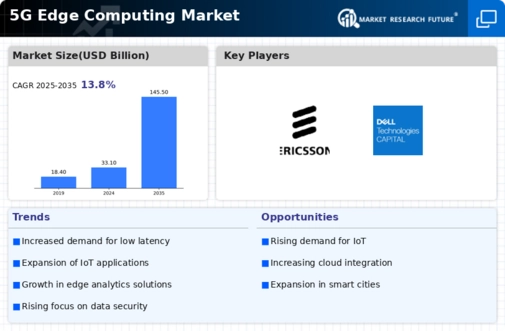Rise of Autonomous Systems
The 5G Edge Computing Market is poised for growth due to the rise of autonomous systems across various sectors. From self-driving cars to drones, these systems rely heavily on real-time data processing and low-latency communication, both of which are facilitated by 5G edge computing. The market for autonomous vehicles alone is projected to exceed 800 billion by 2030, underscoring the critical role of edge computing in enabling these technologies. As organizations invest in autonomous solutions, the demand for 5G edge computing infrastructure is likely to increase, driving innovation and development in this space.
Enhanced Network Performance
The 5G Edge Computing Market is experiencing a surge in demand due to the enhanced network performance offered by 5G technology. With its ability to provide ultra-low latency and high-speed connectivity, 5G enables real-time data processing at the edge. This is particularly crucial for applications such as autonomous vehicles and smart cities, where immediate data analysis is essential. According to recent estimates, the 5G Edge Computing Market is projected to grow at a compound annual growth rate of over 30% through the next few years. This growth is driven by the need for faster and more reliable network performance, which is becoming increasingly vital in various sectors, including healthcare, manufacturing, and entertainment.
Increased Demand for Edge Analytics
The 5G Edge Computing Market is witnessing a notable increase in demand for edge analytics solutions. As organizations seek to derive actionable insights from data generated at the edge, the need for advanced analytics tools becomes paramount. This trend is fueled by the proliferation of IoT devices, which are expected to reach over 75 billion by 2025. The ability to process data closer to its source not only reduces latency but also minimizes bandwidth usage, making edge analytics a critical component of the 5G Edge Computing Market. Companies are increasingly investing in edge computing infrastructure to leverage these analytics capabilities, thereby enhancing operational efficiency and decision-making processes.
Growing Focus on Cybersecurity Solutions
The 5G Edge Computing Market is increasingly focusing on cybersecurity solutions as the number of connected devices rises. With the expansion of edge computing, the potential attack surface for cyber threats also grows, necessitating robust security measures. Organizations are prioritizing the implementation of advanced cybersecurity protocols to protect sensitive data processed at the edge. The 5G Edge Computing is expected to reach over 300 billion by 2025, with a significant portion attributed to edge computing security solutions. This trend indicates a critical intersection between 5G edge computing and cybersecurity, as businesses seek to safeguard their operations while leveraging the benefits of edge technology.
Support for Smart Manufacturing Initiatives
The 5G Edge Computing Market is significantly influenced by the growing support for smart manufacturing initiatives. As industries adopt Industry 4.0 principles, the integration of 5G edge computing becomes essential for optimizing production processes. The ability to connect machines and devices in real-time allows for improved monitoring and control, leading to increased productivity and reduced downtime. Reports indicate that the smart manufacturing sector is expected to reach a valuation of over 500 billion by 2025, with 5G edge computing playing a pivotal role in this transformation. This trend highlights the necessity for robust edge computing solutions that can handle the complexities of modern manufacturing environments.


















Leave a Comment